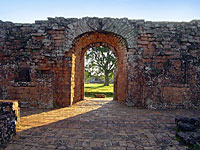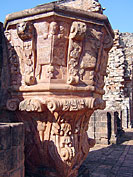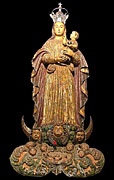- HOME
- HISTORY
- CURRICULUM
- AUDIO/VIDEO
- WHAT'S NEW

 |
 |
| HISTORICAL SHORT NOTICE: “The land without evil”, “The Musical Nation of the Jesuits”, “The Republic of God” are some among the many references given to describe one of the most exceptional episodes in human history, which influenced the social and cultural reality of South America: the Jesuitic Reductions.  Since 1609 the Jesuits transformed the natives’ way of living as isolated nomadic peoples spread in different tribes inside the forest into citizens of organised villages following rules and having duties to respect, but also with significant privileges as members of this community. Law was administered by native judges and police. Penalties included flogging, imprisonment and banishment, but there was no capital punishment. In a few years they changed from a Proto Neolithic level to an organised and civilised level very close to the one existing in Europe in the early 18th Century. Savage hunters and fishermen became expert farmers, artisans and artists. Musicians had a fundamental position inside the community for their important role in playing and singing during the daily religious celebrations and for the community feasts and events such as parades and operas, which usually took place in the main square. Since 1609 the Jesuits transformed the natives’ way of living as isolated nomadic peoples spread in different tribes inside the forest into citizens of organised villages following rules and having duties to respect, but also with significant privileges as members of this community. Law was administered by native judges and police. Penalties included flogging, imprisonment and banishment, but there was no capital punishment. In a few years they changed from a Proto Neolithic level to an organised and civilised level very close to the one existing in Europe in the early 18th Century. Savage hunters and fishermen became expert farmers, artisans and artists. Musicians had a fundamental position inside the community for their important role in playing and singing during the daily religious celebrations and for the community feasts and events such as parades and operas, which usually took place in the main square.
 The
expression commonly used by visitors and biographers to describe the
Jesuitic Reductions in South America: “The Musical Nation”
can be considered an exaggeration, but the artistic vocation of the
Guarany Indians is recorded in many documents and chronicles written
by Europeans visiting these villages. The first missionaries noticed
how the Indians had been completely awe-struck by European music,
standing motionless for hours listening to the magic voices of the
instruments. They were so moved by the music that one Jesuit was prompted
to write to his superiors: “Give me an orchestra, and I will convert
all South America”. Music was played by Indian orchestras, who
reproduced musical instruments from Europe. Masses were accompanied
by a choir and musicians who played chirimias, harps and violins.
All Indian villages had their own choirs, musical bands, and string
orchestra, with 30 to 40 musicians in each settlement. The
expression commonly used by visitors and biographers to describe the
Jesuitic Reductions in South America: “The Musical Nation”
can be considered an exaggeration, but the artistic vocation of the
Guarany Indians is recorded in many documents and chronicles written
by Europeans visiting these villages. The first missionaries noticed
how the Indians had been completely awe-struck by European music,
standing motionless for hours listening to the magic voices of the
instruments. They were so moved by the music that one Jesuit was prompted
to write to his superiors: “Give me an orchestra, and I will convert
all South America”. Music was played by Indian orchestras, who
reproduced musical instruments from Europe. Masses were accompanied
by a choir and musicians who played chirimias, harps and violins.
All Indian villages had their own choirs, musical bands, and string
orchestra, with 30 to 40 musicians in each settlement. Following the expulsion of the Jesuits from South America in 1767 everything was sacked, burned and destroyed. We had just ruins left or a few sculptures or objects spread all over the world in private homes collections and museums, but no sign at all of the music performed there. Nature instead protected a fantastic treasure for over two centuries in the province of Chiquitos in Bolivia. In 1972 the Swiss architect Hans Roth found 11 intact Churches belonging to villages still reproducing the same plan of the Jesuitic Reductions. Inside the Churches of San Rafael and Santa Ana, he found 5.000 manuscripts of the original sacred music performed in those churches and in all the Jesuitic Reductions in the Continent. What people are listening at our concerts is just a sample of “baroco sur americano” (South American Baroque). It’s not a music performed softly in old churches in Europe or whispered singing in a rich salon with musician suitably dressed in their uniforms. What you are listening is a completely different thing, although the music has basically the main characteristics of European baroque respected. Those who were singing and playing this music were poor Indians, considered “savage” and without a soul. They sang and played in order to proclaim their new faith and their praise to God, and to express the joy of living which cannot be whispered or just skimmed over instruments. They had to overcome the forest’s sound, the blowing of the wind and the singing of birds. THE QUALITY OF THE MUSIC: Those who had the opportunity to watch the famous movie “Mission” directed by Roland Joffe, with Robert De Niro will remember the emotion it generated knowing the story of the Jesuitic Reductions in South America. This story created curiosity especially about its cultural and musical aspects and many sceptics could not believe that primitive Indios between 17th and 18th Century reached such a high artistic level to be compared with Europeans. Another reason about this distrust comes from the general ignorance on this unique social, political and cultural phenomenon in the history of mankind. nella storia dell’umanitŕ.  Many
documents exist witnessing the cultural level of the Jesuitic Reductions
in South America. As far as the music is concerned, before 1972 we
just had the description of it and a list of instruments plaid and
built by the Indios themselves, but no scores had been found to play
this music again. Many
documents exist witnessing the cultural level of the Jesuitic Reductions
in South America. As far as the music is concerned, before 1972 we
just had the description of it and a list of instruments plaid and
built by the Indios themselves, but no scores had been found to play
this music again. Now that 5,000 manuscripts of this music have been found in Bolivia, we can prove what documents referred about the beauty of this fantastic music. We can perform the original scores giving the audience the possibility to realize the level of knowledge of baroque music the savage population of South America reached under the guidance of Jesuits. The Italian Domenico Zipoli Ensemble started to study, transcribe, perform and spread this music the world over since 1995, followed byMaestro Luis Szarán from Paraguay, who was among the first musicologists who studied the manuscripts discovered in Bolivia in 1972. We usually perform a Conference & Concert using a power point presentation explaining the story of the Music in the Jesuitic Reductions in South America and as a guida to follow the program in the best way. We chose to use modern instruments as we have no original instruments left and available of those manufactured by the Indians Guarany in South America. - - - Follows: The Music in the Reductions . . ., History of a meeting, Examples of music manuscripts |
| Copyright © 2015 - DZE - C.F.: FRNGRG47P29A757V |